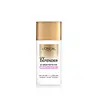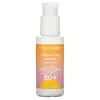L'Oreal UV Defender UV Serum Protector Sunscreen SPF 50+ Versus Neutrogena Invisible Daily Defense Face Serum SPF 60+
What's inside
What's inside
 Key Ingredients
Key Ingredients

 Benefits
Benefits

 Concerns
Concerns

 Ingredients Side-by-side
Ingredients Side-by-side

Water
Skin ConditioningEthylhexyl Methoxycinnamate
UV AbsorberTitanium Dioxide
Cosmetic ColorantSqualane
EmollientGlycerin
HumectantDrometrizole Trisiloxane
UV AbsorberTerephthalylidene Dicamphor Sulfonic Acid
UV AbsorberPropylene Glycol
HumectantAlcohol Denat.
AntimicrobialTriethanolamine
BufferingDipropylene Glycol
HumectantMica
Cosmetic ColorantStearic Acid
CleansingPotassium Cetyl Phosphate
EmulsifyingTocopherol
AntioxidantNylon-12
CI 77891
Cosmetic ColorantNiacinamide
SmoothingSodium Cocoyl Sarcosinate
CleansingSodium Chloride
MaskingPhenoxyethanol
PreservativeDiethylamino Hydroxybenzoyl Hexyl Benzoate
UV FilterPaeonia Suffruticosa Root Extract
Skin ProtectingThermus Thermophillus Ferment
Skin ConditioningPEG-100 Stearate
Ethylhexyl Triazone
UV AbsorberTrisodium Ethylenediamine Disuccinate
Palmitic Acid
EmollientPolysorbate 80
EmulsifyingLimonene
PerfumingXanthan Gum
EmulsifyingLinalool
PerfumingTromethamine
BufferingIsohexadecane
EmollientCaprylyl Glycol
EmollientAlpha-Isomethyl Ionone
PerfumingCI 77120
Cosmetic ColorantCarbomer
Emulsion StabilisingAcrylamide/Sodium Acryloyldimethyltaurate Copolymer
Emulsion StabilisingMyristic Acid
CleansingSorbitan Oleate
EmulsifyingBis-Ethylhexyloxyphenol Methoxyphenyl Triazine
Skin ConditioningCetyl Alcohol
EmollientButylene Glycol
HumectantBHT
AntioxidantButyrospermum Parkii Seedcake Extract
Skin ProtectingPotassium Sorbate
PreservativeAluminum Hydroxide
EmollientHexyl Cinnamal
PerfumingGlyceryl Stearate
EmollientParfum
MaskingWater, Ethylhexyl Methoxycinnamate, Titanium Dioxide, Squalane, Glycerin, Drometrizole Trisiloxane, Terephthalylidene Dicamphor Sulfonic Acid, Propylene Glycol, Alcohol Denat., Triethanolamine, Dipropylene Glycol, Mica, Stearic Acid, Potassium Cetyl Phosphate, Tocopherol, Nylon-12, CI 77891, Niacinamide, Sodium Cocoyl Sarcosinate, Sodium Chloride, Phenoxyethanol, Diethylamino Hydroxybenzoyl Hexyl Benzoate, Paeonia Suffruticosa Root Extract, Thermus Thermophillus Ferment, PEG-100 Stearate, Ethylhexyl Triazone, Trisodium Ethylenediamine Disuccinate, Palmitic Acid, Polysorbate 80, Limonene, Xanthan Gum, Linalool, Tromethamine, Isohexadecane, Caprylyl Glycol, Alpha-Isomethyl Ionone, CI 77120, Carbomer, Acrylamide/Sodium Acryloyldimethyltaurate Copolymer, Myristic Acid, Sorbitan Oleate, Bis-Ethylhexyloxyphenol Methoxyphenyl Triazine, Cetyl Alcohol, Butylene Glycol, BHT, Butyrospermum Parkii Seedcake Extract, Potassium Sorbate, Aluminum Hydroxide, Hexyl Cinnamal, Glyceryl Stearate, Parfum
Water
Skin ConditioningButyloctyl Salicylate
Skin ConditioningGlycerin
HumectantAlcohol Denat.
AntimicrobialSilica
AbrasiveDimethicone
EmollientAluminum Starch Octenylsuccinate
AbsorbentPolyurethane-62
Phenoxyethanol
PreservativePentylene Glycol
Skin ConditioningSodium Acryloyldimethyltaurate/Vp Crosspolymer
Emulsion StabilisingAcrylates/Dimethicone Copolymer
Skin ConditioningGlyceryl Stearate
EmollientChlorphenesin
AntimicrobialStyrene/Acrylates Copolymer
Zingiber Officinale Root Extract
MaskingMenthyl Lactate
MaskingTocopheryl Acetate
AntioxidantDisodium EDTA
Trideceth-6
EmulsifyingChrysanthemum Parthenium Flower/Leaf/Stem Juice
AntioxidantSodium Hydroxide
BufferingCI 19140
Cosmetic ColorantCI 16035
Cosmetic ColorantWater, Butyloctyl Salicylate, Glycerin, Alcohol Denat., Silica, Dimethicone, Aluminum Starch Octenylsuccinate, Polyurethane-62, Phenoxyethanol, Pentylene Glycol, Sodium Acryloyldimethyltaurate/Vp Crosspolymer, Acrylates/Dimethicone Copolymer, Glyceryl Stearate, Chlorphenesin, Styrene/Acrylates Copolymer, Zingiber Officinale Root Extract, Menthyl Lactate, Tocopheryl Acetate, Disodium EDTA, Trideceth-6, Chrysanthemum Parthenium Flower/Leaf/Stem Juice, Sodium Hydroxide, CI 19140, CI 16035
Ingredients Explained
These ingredients are found in both products.
Ingredients higher up in an ingredient list are typically present in a larger amount.
Alcohol Denat. is an alcohol with a denaturant property. It is created by mixing ethanol with other additives.
This ingredient gets a bad rep because it is irritating and drying - mostly due to its astringent property. Astringents draw out natural oils in tissue, constricting pores and leaving your skin dried out.
However, alcohol denat. is not all that bad.
Due to its low molecular weight, alcohol denat. tends to evaporate quickly. One study on pig skin found half of applied alcohol evaporated in 10 seconds and less than 3% stayed on skin.
This also helps other ingredients become better absorbed upon application.
Studies are conflicted about whether this ingredient causes skin dehydration. One study from 2005 found adding emollients to propanol-based sanitizer decreased skin dryness and irritation. Another study found irritation only occurs if your skin is already damaged.
Small amounts of alcohol are generally tolerated by oily skin or people who live in humid environments.
The rule of thumb is if this alcohol is near the end of an ingredients list, it will probably not affect your skin much.
Also...
This ingredient has antimicrobial and solvent properties.
The antimicrobial property helps preserve products and increase their shelf life. As a solvent, it helps dissolve other ingredients.
Other types of astringent alcohols include:
Learn more about Alcohol Denat.Glycerin is already naturally found in your skin. It helps moisturize and protect your skin.
A study from 2016 found glycerin to be more effective as a humectant than AHAs and hyaluronic acid.
As a humectant, it helps the skin stay hydrated by pulling moisture to your skin. The low molecular weight of glycerin allows it to pull moisture into the deeper layers of your skin.
Hydrated skin improves your skin barrier; Your skin barrier helps protect against irritants and bacteria.
Glycerin has also been found to have antimicrobial and antiviral properties. Due to these properties, glycerin is often used in wound and burn treatments.
In cosmetics, glycerin is usually derived from plants such as soybean or palm. However, it can also be sourced from animals, such as tallow or animal fat.
This ingredient is organic, colorless, odorless, and non-toxic.
Glycerin is the name for this ingredient in American English. British English uses Glycerol/Glycerine.
Learn more about GlycerinGlyceryl Stearate is a mix of glycerin and stearic acid.
It is used to stabilize the mixing of water and oil ingredients. By preventing these ingredients from separating, it can help elongate shelf life. It can also help thicken the product's texture.
As an emollient, it helps soften skin and supports barrier-replenishing ingredients.
In cosmetics, Glyceryl Stearate is often made from vegetable oils or synthetically produced.
This ingredient may not be fungal-acne safe
Fun fact: The human body also creates Glyceryl Stearate naturally.
Learn more about Glyceryl StearatePhenoxyethanol is a preservative that has germicide, antimicrobial, and aromatic properties. Studies show that phenoxyethanol can prevent microbial growth. By itself, it has a scent that is similar to that of a rose.
It's often used in formulations along with Caprylyl Glycol to preserve the shelf life of products.
Water. It's the most common cosmetic ingredient of all. You'll usually see it at the top of ingredient lists, meaning that it makes up the largest part of the product.
So why is it so popular? Water most often acts as a solvent - this means that it helps dissolve other ingredients into the formulation.
You'll also recognize water as that liquid we all need to stay alive. If you see this, drink a glass of water. Stay hydrated!
Learn more about Water